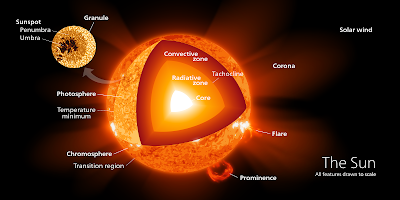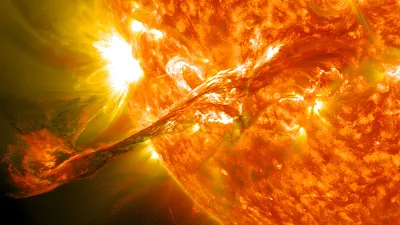SOLAR SYSTEM FAMILY-FACTS ABOUT THE SUN
Every single morning, a blazing red ball of fire, slowly rising above the eastern horizon brings forth a day stuffed with replenished vigour and vitality. As the little birdies chirp and bathe in warm light, we become eager to smack our alarm clocks, sip a bit of coffee and get ready for a new day. So from this little introduction, it is evident that we are talking about the ''Sun''; a giant nuclear reactor converting 600 million tons of hydrogen ions into helium ions every second, and blasting the surrounding interplanetary space with heat, light and funky radiation.
A Bit of Mythology: Man has always been fascinated by the sheer glory of our parent star. And somehow, the ancient cultures realized its immense contribution for the survivability of all life on Earth, including man. Thus in time, Sol found himself as man's supreme god, who not only thawed the dark and fearful night, but also became a stern deliverer of justice, wisdom, and enlightenment. The early Egyptians recognized the Sun as their supreme Sun God or Ra-the highest among the higher Egyptian Gods. They also gave a wonderful description about the Sun's motion along the sky from east to west. According to their mythology, the Sun God rises young as ''Kheper'', appears at noon in the Zenith as the full grown ''Ra'', and sets in the west with old age as ''Atum''. The Egyptians also glorified Ra by making him the creator and nourisher of Earth. Other cultures viz., the Sumerians, Akkadians, Indians, Greeks and Romans also gave a higher place to their respective Sun Gods. The ancient Indians worshipped Sun as ''Suryadevta'', the lord of light and day, whom the Greeks knew as ''Helios'' and the Romans as ''Sol''.
 |
| Sun rising from the eastern horizon/Credits: Photo by form PxHere |
Basic Facts: According to stellar classifications, our Sun is a G-type main-sequence star i.e., an average star with a surface temperature of 5800K(6073℃). The Sun powers itself from the nuclear fusion reaction between ions of hydrogen and subsequent liberation of energy, that takes somewhere between 10,000 to 170,000 years to escape into outer-space in the form of electromagnetic radiation and heat.
Characteristics:
- Formation- The Sun is a Population I star, being composed of nearly 75% hydrogen, 24% helium and traces of metals like carbon, neon, oxygen, nitrogen, silicon, iron, sulfur and magnesium. Like other stars, our Sun also developed from the gravitational collapse of a dense molecular cloud of hydrogen gas, over a span of 50 million years. This gravitational collapse was aided by a nearby supernova, which is evident from the abundance of heavier elements like gold and uranium in our solar system. Almost 99% of the molecular cloud coalesced to form the Sun, while the remaining settled around in an accretion disc and formed the planets and other celestial bodies.
- A Nuclear Reactor- The Sun generates energy from two types of nuclear reactions viz., the proton-proton chain reaction and the CNO Cycle. The proton-proton chain reaction or the p-p chain reaction produces the maximum amount of energy, while a very small fraction comes from the CNO Cycle. In the p-p chain reaction, two protons fuse together to form deuterium. This deuterium then fuses with another proton and produces helium-3 isotope, which further fuses with itself to form helium-4 and protons. The overall reaction is: 4 ¹H⁺→4 He²⁺ + 2e⁺ + 2vₑ. This releases 26.73 MeV of energy, with some of it getting lost to the neutrinos and gamma rays, and heats up the stellar core to millions of degrees Kelvin. And in turn, the outpouring radiation pressure balances the Sun from collapsing on itself due to the action of gravity. A very small amount of energy comes from the CNO Cycle. The CNO Cycle is also a fusion reaction of hydrogen which occurs under the catalytic action of carbon, nitrogen and oxygen molecules. These energies are emitted in the electromagnetic spectrum, with majority lying in the visible, ultraviolet, infrared and smaller portions via radio-waves or gamma ray. The amount of solar energy received per square-metre area at 1 AU from the Sun, called the Solar Constant is 1,368W/m². The solar energy reaching Earth's surface is 1,000W/m², as some of it gets filtered(blocked/absorbed) by the Earth's atmosphere.
 |
| Cross-section view of the Sun/Credits: Kelvinsong, CC BY-SA 3.0,via Wikimedia Commons |
- Internal Composition- The sun is divided into the following four layers. They are as follows:
- Core- The core is like a reactor hall that occupies nearly 25% of the sun's 695,700 km long radius. The core generates a staggering energy of 9.192×1010 megatons of TNT from the fusion of 600 million tons of hydrogen into 596 tons of helium per second, and has a temperature of 15,700,000K compared to a mere 5800K of surface temperature. The total energy required to maintain the hydrostatic equilibrium is generated within the core, while the rest of the Sun is heated by radiation and convection of this energy in the subsequent layers.
- Radiative Zone-The region that succeeds the core is the radiative zone where energy transfer occurs by means of radiation. Because of the high density of matter in this region, energy in the form of gamma ray photons can only travel for a very short distance before getting scattered by a a matter particle. As a result of this it takes an average of 170,000 years for gamma ray photons to leave the radiative zone and reach the next layer. The radiative zone starts from 25% of the solar radius, extending up to 70%.
- Tacholine- This is a boundary region between the radiative and convective zone of the sun.
- Convective Zone- The convection zone extends from 70% of the solar radii to the base of the photosphere. In this region the solar plasma is less dense compared to the radiative zone and as a result energy transfer occurs by the means of convection currents. Thermal cells develop in this region which carry the heat generated from the core towards the photosphere.
- Photosphere- The only part of the Sun that can be observed is the photosphere; the region through which photons escape out into the interstellar space. Below the photosphere the Sun is dark to visible light, meaning light or radiation is extremely diffused, owing to the higher density of matter. The photons below the photosphere continually gets re-emitted in different directions and re-absorbed by the ions of hydrogen. The photosphere also contains bright regions of extremely hot solar plasma called granules, and relatively cool and dark regions called sunspots. During 1868, an English astronomer Sir Joseph Norman Lockyer was observing the absorption spectrum of the photosphere. In the absorption spectra, there were some absorption lines which didn't correspond to any known elements then found on Earth. So he suggested the possibility of a new element, ''HELIUM'' from the Greek word ''HELIOS''. Twenty-five years later, helium was finally isolated on Earth by a Scottish Scientist, Sir William Ramsay.
- Atmosphere- The Sun has an extremely dynamic atmosphere, which is subdivided into three distinct regions- the chromosphere, the transition region, and the corona. The solar atmosphere starts just 500 km above a region of minimum temperature starting from the photosphere where temperature stays below 4100 K, containing simple molecules like carbon monoxide and water. The chromosphere extends from this minimum temperature region to 2000 km above the photosphere. The word ''chromosphere'' is derived from the Greek word ''chroma'' meaning light, as this region is visible as a colored flash during the start and end of a solar eclipse. The chromosphere has a temperature of 20,000 K at the top where helium starts to become partially ionized. Between the chromosphere and the solar corona there lies a transition region where temperature ranges between 20,000 K to 10,000,000 K. Here helium is fully ionized and the region is opaque to visible light but can be observed with instruments sensitive to extreme ultraviolet wavelength. The corona is the final layer of the solar atmosphere extending to 8,000,000 km above the photosphere or nearly 12 times the solar radii, and occupies a volume greater than that enclosed by the photosphere. The corona is the hottest region of the sun, having a staggering temperature ranging from 1,000,000 K to 20,000,000 K. Apart from these the sun also possess a a very thin veil of solar wind plasma that extends far beyond the orbit of Pluto, and shields the solar system from the bombardment of deadly amounts of cosmic rays originating from the depths of space. In 2012, the Voyager 1 spacecraft and in 2018, Voyager 2 became the only man-made objects to leave the heliosphere and head towards interstellar space.
- Magnetic Field and Magnetic Activity-The Sun being a spherical body of super-heated plasma undergoes differential rotation, as the surface moves at different speeds at different latitudes. Because of this differential rotation, the magnetic field does not remain constant and homogeneous across the surface of the Sun. The magnetic activity corresponds to a 11 year solar cycle, when the Sun moves through periods of minimum to maximum activity with varying degree of sunspot formations. Sunspots are dark patches visible on the solar photosphere, and are subsequently cooler than the surrounding regions. In regions, where the magnetic field is twisted more and more owing to the differential rotation, the magnetic lines of force snap like a stretched rubber band and sunspots are formed. Sunspots are regions of intense magnetic activity where the magnetic field exits the photosphere. The Sun also emits a stream of energetic particles called solar flares/solar storms, a direct consequence of this twisted magnetic field. This extremely strong field also extends far beyond the outer solar system, and forms the heliosphere which ultimately acts as a shielding from interstellar cosmic rays.
 |
| CME as observed by the Solar Dynamics Observatory/Credits: NASA Goddard Space Flight Center, CC BY 2.0 , via Wikimedia Commons |
- Orbital and Rotational Characteristics- Just like planets are in an orbit around our Sun, the latter is also in an orbit around the centre of the Milky Way Galaxy. The Sun takes one galactic year i.e, 225-250 million Earth years to go once about the galactic centre. The orbital velocity of the whole solar system is about 251km/s. Within the Milky Way the Sun is located close to the inner rim of the galaxy's Orion Arm, in the local interstellar cloud, and at a distance of 7.5-8.5 kiloparsecs or 24-28,000 light years from the galactic centre. Within the solar system the Sun moves about the barycenter of the eight planets and itself. This happens due to the gravitational pull of the Sun on the planets and vice versa. Being a gaseous body, it does not have to rotate rigidly about an axis like a terrestrial planet or a rocky moon. In fact, the Sun spins faster near the equator(equivalent to 24 earth days) compared to the poles(equivalent to 35 earth days).
- Observations- The Sun has always sparked a bit of a sensation among men because its absence brought a long and dreadful night. So our Helios found its place as a solar deity amongst the early civilizations. Apart from being a deity, the Sun also played an important role in the development of scientific understanding and rationalism. While the early society found it easy to accept a flat-earth as the centre of the solar system, rational men like Aristarchus of Samos, Seleucus of Seleucia, Nicolaus Copernicus had their faith in the contrary, with the Sun being the center of the solar system. And gradually, the truth was established that the Sun was at the center and all planets revolved around it. Sir Issac Newton also made an important discovery by passing white light through a prism. It was found that sun-light(white light) is composed of seven different colors. The Sun in modern times also became the candidate for the testing of various scientific theories, from electromagnetic theory, to nuclear physics and general relativity.
- Explorations-There has been many voyages to the Sun, with a few being the most successful missions in the domain of space explorations. They are as follows.
- The first exploration started with NASA's Pioneer Missions viz., Pioneer-6,7,8,9 launched during 1959-1968. The pioneer space probes orbited the sun at an average distance of 0.8-1.1 AU i.e, roughly at the earth-sun distance and collected data about the solar wind and the Sun's magnetic field.
- During the 1970s the USA and Germany under joint collaboration created the Helios Spacecrafts. The Helios-1 and the Helios-2 probes studied the solar wind from a position inside Mercury's orbit at perihelion. The Skylab launched by NASA had a module specifically designed for solar observation called the Apollo Telescope Mount that provided real-time observations of the sun. The Skylab did extensive research on the solar corona, its ultraviolet emissions, coronal mass ejections and coronal holes.
- In 1980 NASA launched another mission-The Solar Maximum Mission to study the Sun during its period of high solar activity and luminosity. In 1991 the Japan's Yohkoh satellite observed the Sun in X-ray wavelengths that helped scientists to identify several types of solar flares.
- Next comes the most important and successful mission-The SOHO or the Solar and Heliospheric Observatory, a joint venture by the ESA and NASA, launched on December 2, 1995. The SOHO is situated at the Sun-Earth Lagrange Point, a stable region of gravitational influence in Earth's orbit. The main objectives of SOHO were investigation of the chromosphere, the transition region, the corona and detailed observations of the solar wind. The SOHO is still up and running and provides immense data to the scientists.
- Since the former probes could only observe the Sun from the plane of the ecliptic, so scientists decided for a mission to observe the polar regions. Thus the Ulysses spacecraft was launched in 1990, and used a gravitational slingshot from Jupiter which placed the probe in high solar latitudes, above the plane of the ecliptic.
- NASA also decided to bring back particles from the solar wind and so Genesis was launched in August 8, 2001 and returned to Earth on September 8, 2004.
- The STEREO or Solar Terrestrial Relations Observatory was launched on October 26, 2006 for stereoscopic analysis of coronal mass ejections from the sun, and consisted of two probes.
- The Parker Solar Probe was launched on August 12, 2018 and is scheduled to reach the Sun in 2025. The Parker Solar Probe is going to be the first manmade object positioned closest to the Sun, only a separation of 6.9 million km or 0.046 AU. The probe is designed to collect data on the solar corona, the solar magnetic field and its mechanisms for the acceleration of energetic particles.
- The Indian Space Research Organization(ISRO) has also developed a spacecraft, Aditya L-1 which is scheduled to be launched in January 2022.
 |
| The solar corona can only be seen when the moon comes directly in front of the Sun/Credits: Bernd Thaller from Graz, Austria, CC BY 2.0,via Wikimedia Commons |
Very Distant Future- Nothing stays the same for all eternity, and neither does the Sun. From the day Helios was born by the collapse of a molecular gas cloud it has been slowly gravitating towards a grand finale; not a cataclysmic supernova but a gradual shedding of its outer layers. The Sun is mainly powered by the fusion of hydrogen nuclei into helium and liberation of energy, which has been going efficiently for 5 billion years since its fiery birth. Within another 5 billion years from now, the hydrogen supply in the Sun's core would come to an end. This depletion will result in an instability in the hydrostatic equilibrium and subsequently the Sun would undergo an increase in size and luminosity, slowly leaving the main sequence of the HR Diagram and transforming into a red giant. After becoming a red giant the Sun would continue to fuse helium in its core into carbon, and hydrogen would burn in a shell surrounding the core. Since helium fusion is not efficient in liberating energy like hydrogen, the Sun would undergo a gravitational collapse and shed its outer layers. This shedding would leave behind a white dwarf, a dense carbon-oxygen stellar remnant, glowing from the residual heat of previous fusion reactions. The gradually cooling white dwarf star would linger for billions(maybe trillions!) of years till it ultimately settles down as a pile of degenerate matter.
During its Red Giant phase the Sun would swell enough to engulf the inner planets-Mercury and Venus, and transform Earth into a charred remains of a once called blue marble. With increasing solar luminosity, carbon dioxide levels on Earth would fluctuate enough to make life suffer catastrophically and after a certain era all life would end on Earth. With increasing size the habitable zone will also start to shift towards Mars and finally to Jupiter and Saturn. Thus, the shifting habitable zone leaves a possibility for life to flourish on some of Saturn's moons. If humans could ever become an interstellar civilization then they could migrate and settle in some other star systems and witness the final hours of our star's life; but that's another story.
Some Quick Facts!



Comments
Post a Comment